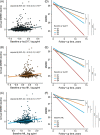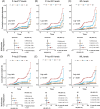Plasma p-tau217, p-tau181, and NfL as early indicators of dementia risk in a community cohort: The Shanghai Aging Study
- PMID: 38145191
- PMCID: PMC10740382
- DOI: 10.1002/dad2.12514
Plasma p-tau217, p-tau181, and NfL as early indicators of dementia risk in a community cohort: The Shanghai Aging Study
Abstract
Introduction: Blood biomarkers showed values for predicting future cognitive impairment. Evidence from the community-based cohort was limited only in high-income countries.
Methods: This study included 1857 dementia-free community residents recruited in 2009-2011 and followed up in waves 2014-2016 and 2019-2023 in the Shanghai Aging Study. We intended to explore the relationships of baseline plasma ALZpath phosphorylated tau 217 (p-tau217), p-tau181, neurofilament light chain (NfL) with follow-up incident dementia, Alzheimer's disease (AD), and amyloidosis.
Results: Higher concentrations of plasma p-tau217, p-tau181, and NfL were correlated to higher decline speed of Mini-Mental State Examination score, and higher risk of incident dementia and AD. The p-tau217 demonstrated a significant correlation with longitudinal neocortical amyloid-beta (Aβ) deposition (r = 0.57 [0.30, 0.76]) and a high accuracy differentiating Aβ+ from Aβ- at follow-ups (area under the receiver operating characteristic curve = 0.821 [0.703, 0.940]).
Discussion: Plasma p-tau217 may be an early predictive marker of AD and Aβ pathology in older community-dwelling individuals.Highlights: Plasma p-tau217, p-tau181, and NfL were positively associated with long-term cognitive decline and risk of incident dementia.Plasma p-tau217 showed a better performance distinguishing Aβ+ individuals from Aβ- individuals at follow-ups.Plasma NfL may be a suitable predictor of general cognitive decline in older community-dwelling individuals.
Keywords: Alzheimer's disease; Aβ; biomarker; cohort; community; dementia.
© 2023 The Authors. Alzheimer's & Dementia: Diagnosis, Assessment & Disease Monitoring published by Wiley Periodicals LLC on behalf of Alzheimer's Association.
Conflict of interest statement
Dr Ding reported receiving grants from Shanghai Municipal Science and Technology Major Project and ZJ LAB, Shanghai Municipal Health Commission, National Natural Science Foundation of China, and Key Project of the Ministry of Science and Technology, China. Dr Zhao reported receiving grants from Shanghai Hospital Development Center, the National Natural Science Foundation of China, and MOE Frontiers Center for Brain Science. Dr Liang reported receiving grants from Shanghai Sailing Program. All payments were made to the institution. No other disclosures were reported. Author disclosures are available in the supporting information.
Figures




References
LinkOut - more resources
Full Text Sources
